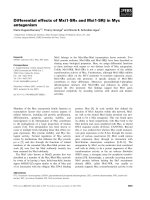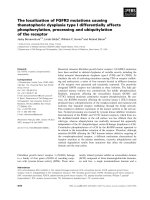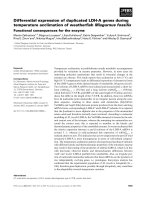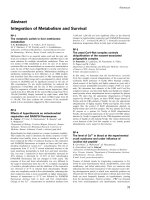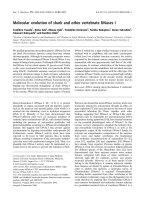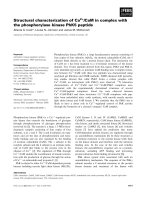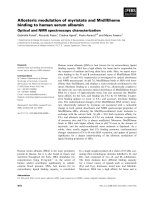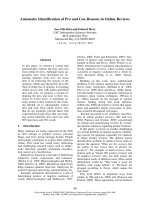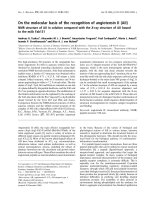Báo cáo khoa học: Differential interactions of decorin and decorin mutants with type I and type VI collagens pptx
Bạn đang xem bản rút gọn của tài liệu. Xem và tải ngay bản đầy đủ của tài liệu tại đây (407.37 KB, 10 trang )
Differential interactions of decorin and decorin mutants with type I
and type VI collagens
Gordon Nareyeck
1
, Daniela G. Seidler
1
, David Troyer
2
,Ju¨ rgen Rauterberg
2
, Hans Kresse
1
and Elke Scho¨ nherr
1,3
1
Departement of Physiological Chemistry and Pathobiochemistry, University Hospital of Mu
¨
nster, Germany;
2
Institute of
Arteriosclerosis Research, University of Mu
¨
nster, Germany;
3
Matrix Biology and Tissue Repair Research Unit, University of Wales
College of Medicine, Dental School, Cardiff, UK
The small leucine-rich proteoglycan decorin can bind via
its core protein to different types of c ollagens such as type
I and type VI. To test whether decorin can act as a
bridging molecule between these collagens, the binding
properties of wild-type decorin, two full-length decorin
species with single amino acid substitutions (DCN
E180K, DCN E180Q), which previously showed reduced
binding to collagen type I fibrils, and a t runcated form of
decorin (DCN Q153) to the these collagens were investi-
gated. In a solid phase assay dissociation constants for
wild-type decorin bound to methylated, therefore mono-
meric, triple helical type I collagen were in the order of
10
)10
M
, while dissociation constants for fibrillar type I
collagen were 10
)9
M
. The dissociation constant for
type VI was 10
)7
M
. Using real-time analysis for a
more detailed investigation DCN E180Q and DCN
E180K exhibited lower association and higher dissoci-
ation constants t o type I collagen, compared to wild-type
decorin, deviating by at least one order of magnitude. In
contrast, the affinities of these mutants to type VI colla-
gen were 10 times higher than the affinity of wild-type
decorin ( K
D
10
)8
M
). Further investigations verified
that complexes of type VI collagen and decorin bound
type I collagen and that the affinity of collagen type VI to
type I was increased by the presence of decorin. These
data show that decorin not only can regulate collagen
fibril formation but that it also can a ct as an intermediary
between type I and type VI collagen and that these two
types of collagen interact via different binding sites.
Keywords: collagen t ype I; collagen type VI; decorin; surface
plasmon r esonance measurements.
Collagens can be divided into several subfamilies according
to their quarternary structure a nd their localization in tissue
[1,2]. The largest subfamily is represented by the banded
fibril forming collagens type I, II and III, which are
characterized by long, uninterrupted triple helical domains
that assemble laterally to form fibrils. I n contrast, another
subfamily, of which type VI collagen is t he only m ember, is
characterized by the formation of multimolecular, filamen-
tous beaded structures [3]. Although banded fibril forming
and filamentous beaded collagens form independent net-
works, they intermingle with each other in vivo,this
association providing for mechanical stab ilization o f t issues.
Electron microscopic studies indicate that the banded fibril
forming collagens are traversed specifically near their ÔdÕ
bands, within the gap region of the collagen fibrils, by the
filamentous beaded structures of the type VI collagen-
containing network [4,5].
Collagen fibrils in tissues a re heteropolymers of several
types of collagen and of noncollagenous components.
For example, collagen fibrils in skin are composed
primarily of type I collagen with minor amounts of type
III and type V collagen. Type III collagen is found on
the fibrillar surface, while type V collagen is buried
mainly within the fibrils [6]. Noncollagenous matrix
glycoproteins are additionally associated with the surface
of the collagen fibrils. Such glycoproteins may in part
substitute for collagen species at the fibrillar surface or
perform auxiliary functions [7]. Some of these matrix
glycoproteins contain leucine-rich repeat structures and
have been shown to modulate c ollagen fibrillogenesis and
the spacing between the mature fibrils. The chondroitin/
dermatan sulphate proteoglycan decorin (DCN) is a
member of this family of small leucine-rich p roteoglycans
(SLRP), which is composed of a core protein and a
single covalently linked glycosaminoglycan chain. It b inds
to collagen fibrils near the d bands (Ôd ecoratesÕ them) and
delays the lateral assembly of collagen fibrils [8,9].
Consequently, targeted disruption of the decorin gene
in mice leads to abnormal fusion of collagen bundles and
to increased f ragility of skin [ 10]. Recently, mic e twofold
Correspondence to E. Scho
¨
nherr, Matrix Biology & Tissue R epair
Research Unit, University of Wales C ollege of Medicine, Dental
School, Heath Park, Cardiff CF14 4XY, UK.
Fax: + 44 29 2074 4509, Tel.: + 44 29 2074 2595,
E-mail: schonherreh@cardiff.ac.uk
Abbreviations: BGN, biglycan; CS/DS, chondroitin sulphate/derma-
tan sulphate; DCN, decorin; GAG, glycosaminoglycan; SLRP, small
leucine-rich repeat proteoglycan.
Note: G. Nareyeck a nd D. G. Seidler c ontribu ted equally to this w ork.
(Received 13 M ay 2004, accepted 30 June 2004)
Eur. J. Biochem. 271, 3389–3398 (2004) Ó FEBS 2004 doi:10.1111/j.1432-1033.2004.04273.x
deficient in the SLRP decorin, biglycan, fibromodulin
and lumican have been generated [11]. Interestingly,
double deficiency in decorin and biglycan manifests itself
in extremely abnormal architecture of the collagen fibrils.
Thus, interactions between the collagens and decorin are
of paramount importance in attaining and maintaining
tissue integrity.
In the present study we investigate the binding properties
of wild-type decorin, two decorin mutants and a truncated
decorin species with type I and type VI collagen to
demonstrate that decorin can act as a bridging molecule.
The results indicate that the tertiary structure of decorin is
stabilized by the glycosaminoglycan chain. Furthermore,
decorin may form a dimer which is capable of interacting
concurrently with both type I and type VI collagen
molecules.
Experimental procedures
Expression and preparation of recombinant
proteoglycans
Wild-type decorin and the decorin mutant DCN E180K
were expressed in human kidney 293 cells as previously
described [12]. DCN E180K harbours an amino acid
exchange at amino acid E180, which is an important site
for the interac tion o f decorin with type I collagen fibrils. A
plasmid harbouring the cDNA for the decorin mutant
DCN E180Q was generated from the respective wild-type
plasmid by a one-step site-directed mutagenesis procedure
(Stratagene) using the primer pair 5 ¢-GGTGCCCAGTTG
TATGACAATC-3¢ and 5¢-GATTGTCTACAACTGGG
CACC-3¢.TheaminoacidatE180inDCNE180Qis
likewise substituted. A cDNA construct for the truncated
decorin species DCN Q153 (M1–Q153), in which six of a
total of 10 leucine-rich repeats are lacking [13], was cloned
into the EcoRI/XbaI site of pcDNA 3.1 (Invitrogen) and
used for transfection with t he Lipofectin (Life Technologies)
method. Biglycan (BGN) was expressed in 293 cells as
described [14].
All proteoglycan preparations were obtained from
conditioned media of transfected 293 cells under condi-
tions without denaturing and/or precipitation steps.
Media, supplemented with protease inhibitors, were
applied directly to a DEAE-Trisacryl M (Serva) and
then to a BioGel TSK DEAE-5PW HPLC column (Bio-
Rad) as described previously [15]. Proteoglycans were
stored at 4 °C in elution buffer (10 m
M
Tris/HCl pH 7.4,
containing 0.6
M
NaCl). Immediately prior to use the
proteoglycans were dialysed against either 18 m
M
sodium
phosphate pH 7.4, 0.15
M
NaCl (NaCl/P
i
)or10m
M
Hepes pH 7.4, 0.15
M
NaCl, 3.4 m
M
EDTA, 0.005%
(v/v) Tween-20 (HBS) at 4 °C. Glycosaminoglycan-free
core protein was generated by exhaustive digestion with
chondroitin ABC lyase (Seikagaku Kogyo) as described
previously [15]. Glycosaminoglycan chains were liberated
by reductive b-elimination with 1
M
sodium borohydride
in 0.1
M
NaOH for 24 h at 37 °C, followed by dialysis
and rechromatography on BioGel TSK DEAE-5 PW as
described above. [
35
S]Sulphate-labelled and [
35
S]methio-
nine-labelled decorin from 293 cells and skin fibroblasts
were obtained as described previously [12,16].
Preparation of methylated type I collagen and
type VI collagen
Type I collagen was isolated from calf skin and methylated
by treatment with 0.2
M
methanolic HCl for 3 d ays at
ambient temperature as described [17]. This treatment
results in the modification of about 70% of all carboxyl
residues. This modification leads to an increase in the pH
and a decrease in the hydrophilic properties. Type VI
collagen was solubilized from bovine placenta by pepsin
treatment and purified by salt fractionation [18].
Surface plasmon resonance analysis
All measurements were performed with a BIAcore 1000
analyser (Pharmacia Biosensor). Methylated type I collagen
was immobilized via its primary a mino groups to a r esearch
grade CM5 sensor chip [19]. During immobilization, a flow
rate of 10 lLÆmin
)1
of HBS was maintained. The surface of
the chip was activated by injecting a mixture of equal
volumes of 0.2
M
N-ethyl-N¢-(3-dimethylaminopropyl)-
carbodiimide and 0.05
M
N-hydroxysuccinimide. There-
after, 70 lL of a solution of methylated type I collagen
(250 lgÆmL
)1
)in20m
M
sodium acetate pH 4.0 was
injected followed by 1
M
ethanolamine/HCl p H 8.5. Injec-
tion times were chosen to achieve about 6000–7000
resonance units (6–7 ng of proteinÆmm
)1
[19]. Type VI
collagen was immobilized via its free sulfhydryl groups.
During immobilization, the flow rate of HBS was main-
tained a t 5 lLÆmin
)1
. T he surface w as activ ated as described
andallowedtoreactwith80 m
M
2-(2 pyridinyldithio)ethane
amine in 0.1
M
sodium borate p H 8.5. At least five coupling
pulses of 240 lL type VI c ollagen (25 0 lgÆmL
)1
)in0.1
M
sodium formiate pH 4.3, were applied until 6000–7000
resonance units were present. The sensor surface was
blocked with 50 m
ML
-cysteine in 0.1
M
sodium formiate
pH 4.3, 1
M
NaCl. BSA was immobilized and used to
determine the proportion of n onspecific binding. The senso r
surfaces were regenerated with 1
M
NaCl in running buffer
for type I collagen-coated chips and with 0.3
M
NaCl in the
case of immobilized type VI collagen.
To form a complex consisting of decorin, type I and type
VI collagen, type VI collagen was first immobilized. After
binding of decorin the sensor chip surface was not
regenerated in order to maintain a high level of bound
proteoglycan. Methylated type I collagen in NaCl/P
i
was
then added to the chip and allowed to interact with the
proteoglycan.
All e xperiments were carried out at 25 °C a t a flow rate of
10 lLÆmin
)1
. The response to the running buffer was
defined as the baseline level, and all responses were
expressed relative to this baseline. Experimental procedures
and c onditions leading to precipitation of protein complexes
in the flow system and the pump of the BIAcore 1000
instrument had to be strictly avoided to protect the system
from damage. For this reason only experiments without
the addition of complexes were performed. For the analysis
of interactions between proteoglycans and collagens, the
sensograms were corrected by a modification of the method
of Roden and Myszka [20]. To correct for changes in
refractive index and nonspecific binding, the responses
obtained with immobilized albumin were subtracted from
3390 G. Nareyeck et al. (Eur. J. Biochem. 271) Ó FEBS 2004
those obtained with bound collagen. The e xperimental data
were then evaluated with the
BIAEVALUATION
3.0 software.
Other binding assays
The binding of [
35
S]sulphate-labelled decorin species and
[
35
S]sulphate-labelled biglycan to reconstituted type I colla-
gen fibrils was performed as described [12]. Solid phase
assays on hydrophilic ELISA strips (Nunc) were used to
investigate interactions with type VI collagen a nd methyla-
ted type I collagen. Type VI collagen (4 lgÆmL
)1
,
50 lLÆwell
)1
) and methylated type I c ollagen (10 lgÆmL
)1
,
100 lLÆwell
)1
)in50m
M
NaHCO
3
pH 9.6, were incubated
for 16 h at 4 °C. After blocking w ith 3% BSA in NaCl/P
i
,
0.05% Tween-20 for 4 h at 37 °C, the wells were washed
twice with ice-cold NaCl/P
i
. Labelled proteoglycans in
NaCl/P
i
(18 m
M
sodium phosphate pH 7.4, 0 .15
M
NaCl)
were applied for 6 h or 3 h at 37 °C. After extensive
washing with b locking solution, bound proteoglycans were
solubilized with 0.1
M
NaOH and neutralized with 0.1
M
HCl prior to scintillation counting. K
D
values were deter-
mined using
PRISM
3.0 (GraphPad Software).
CD spectroscopy
A Jobin-Yvon CD6-Dichrograph spectropolarimeter
(Yvon, France) was used to measure CD spectra at ambient
temperature in NaCl/P
i
in a 0.1-mm path length quartz
cell. Proteoglycan concentrations of 1mgproteinÆmL
)1
were used. Estimations of secondary structure were per-
formed with the
CDNN
2.1 software (ACGT Progenomics
AG, Halle (Saale), Germany).
Electron microscopy
Suspensions of type I collagen in glycerol were s prayed onto
mica sheets w ith a n air brush and rotary shadowed with
platinium-carbon at an angle of about 7°, followed by pure
carbon as described by Cohen et al. [21]. The replicas were
placed on uncoated g rids and analysed w ith a Philips EM
410 electron microscope.
Results
Characterization of purified type I and type VI collagens
Type I collagen fibrils we re generated by neutralization of
acid soluble calf skin collagen as describe d previously [12].
To obtain type I collagen monomers, type I collagen was
methylated which shifts the isoelectric point of the molecule
to a basic pH and increases hydrophobicity. The treated
collagen does not form fibrils under physiological condi-
tions which was confirmed by rotary shadowing (Fig. 1A).
However, the methylated t ype I collagen was still able to
bind to hydrophilic ELISA strips (see below). Bovine type
VI collagen containing three polypeptide chains, a1(VI),
a2(VI) and a3(VI) covalently linked via disulphide bonds
was produced by treatme nt with pepsin t o remove most o f
the C- and N-terminal globular domains (Fig. 1B). Fig. 2
shows the composition of the collagen used in the experi-
ments. Quantitative analysis of the SDS gel electrophoreses
indicated that 63% of the type VI collagen contained the
long chain and 37% the s hort fragment o f the a3(VI) chain
[22].
Characterization of purified decorin and its mutants
Wild-type decorin, DCN E180K, DCN E180Q and DCN
Q153 were purified under nondenaturing conditions from
conditioned medium of 293 cells transfected with the
respective cDNA. No freeze-drying or precipitation steps
were performed to avoid artificial complex formation of
proteoglycans [23]. CD spectroscopy was u sed to determine
whether there are major differences in secondary structure
between the wild-type decorin and the mutants. The CD
spectra of wild-type decorin and DCN E180Q and D CN
E180K appeared similar, whereas that of DCN Q153
differed from tha t of wild -type dec orin (Fig. 3). The CD
Fig. 1. Rotary shadowing of isolated type I and type VI collagen mole-
cules. (A) Methylated type I collagen was visualized as monomers,
whereas (B) pepsin digested type VI collagen appeared as short frag-
ments of beaded filaments.
Ó FEBS 2004 Decorin interacting with type I and VI collagen (Eur. J. Biochem. 271) 3391
spectra of the glycosaminoglycan chain alone, obtained by
reductive b-elimination, yielded only baseline data (not
shown). Evaluation of secondary structure was performed
with the
CDNN
2.1 software. The analysis showed that wild-
type decorin and DCN E180K an d DCN E180Q have 2 1%
a-helical motifs and 29.1% b-sheets (Table 1). These results
show that the point mutations have only minor effects on
the g eneral structure of the decorin core protein. For DCN
Q153, which lacks most of the leucine-rich repeats, 36%
a-helical motifs and only 2 4.1% b-sheets were observed. As
shown in Fig. 4, decorin expressed in 293 cells contained no
free core protein, and the length of the glycosaminoglycan
chain w as similar to that of decorin f rom d ermal fibroblasts .
Fig. 2. Electrophoretic comparison of the composition of pepsin digested
type I collagen, acid treated type I collagen, methylated type I c ollagen
and type V I collagen used in the experiments. Sam ples of the different
types of collagen were applied und er reducing (+DTE) and non-
reducing (–DTE) conditions to a 4–12.5% polyacrylamide gradient
gel. Protein was visualized by staining with Coomassie blue.
Fig. 3. CD spectra of the recombinant decorin e xpressed in 293 cells and
purified under nondenaturing conditions. The spectra were obtained
under physiological conditions in 0.15
M
NaCl. Wild-type d ecorin,
solid line; truncated decorin DCN Q153, dotted line. Spectra for the
decorin mutants DCN E180K and DCN E180Q were indistinguish-
able from that of wild-typ e decorin (not shown).
Table 1. Tentative structural motifs of recombinant decorin. Theoretical
calculation using the program CDNN and the data from by CD
spectra measured between 195 nm to 260 nm. Decorin and the decorin
mutants DCN E 180Q a nd DC N E180K an d t runc ated de corin D CN
Q153 we re purified under nondenaturing co nditio ns from the medium
of 293 cells.
Secondary
structural motif
Decorin
mutants (%)
DCN
Q153 (%)
a-Helical 21.7 35.9
b-Sheet 29.1 24.1
b-Turn 15.4 13.8
Coil 31.1 23.5
Fig. 4. Comparison of decorin synthesized in 293 cells and human
skin fibroblasts. 293 cells transfected with human wild-type decorin
cDNA and human skin fibroblasts were metabolically labelled w ith
[
35
S]methionine. After immunoprecipitation with a monospecific
antibody, decorin proteoglycan and c ore p rotein (o btained b y diges-
tion with cho ndroitin ABC lyase) were sep arated b y S DS/PAGE on
12.5% polyacrylamide gel. Labelled proteins were visualized by
autoradiography. Decorin transfected 293 cells do not synthesize free
core protein. The molecular masses of the proteoglycan and the
core protein are similar to those of the respective molecules from
fibroblasts.
3392 G. Nareyeck et al. (Eur. J. Biochem. 271) Ó FEBS 2004
Interaction of different forms of decorin with type I
collagen
To test the hypothesis that decorin can act as a bridging
molecule between type I and type VI collagen w e first
performed solid phase binding assays to determine that the
binding properties of the different ligands involved.
[
35
S]Sulphate-labelled decorin was incubated with reconsti-
tuted type I collagen fibrils and its binding was compared to
the different mutants. Wild-type decorin i nteracted strongly
with collagen fibrils, DCN E180K reacted weakly and
DCN E180Q moderately (Fig. 5) which agreed with earlier
results [12] and confirmed t he suitability of the mutants.
To test whether methylated type I collagen monomers
which were planed to be used as ligands for a decorin/
collagen type VI complex showed the expected properties
solid phase assays with methylated collagen type I and
decorin or biglycan as ligands were performed. ELISA
plates were coated with th e collagen monomers and
[
35
S]sulphate-labelled proteoglycans were added. These solid
phase assays showed dissociation constants of 2.3 ·
10
)10
M
for decorin and 1.4 · 10
)9
M
for biglycan (data
not shown) indicating that the methylated type I collagen
monomers were suitable binding partners and could be used
for further studies.
The further analysis was performed by surface plasmon
resonance spectroscopy. Collagen monomers of methylated
type I collagen were covalently immobilized to a CM5
sensor chip, and the affinities of wild-type decorin, its core
protein (Fig. 6A) and of the decorin mutants for the
immobilized collagen were measured. Surface plasmon
resonance measurements with decorin and t ype I collagen
performed in the presence or absence of 15 n
M
ZnCl
2
showed little influence of the Zn
2+
ions on the binding
properties of decorin (Fig. 6B). A single binding site
between wild-type decorin and type I collagen monomers
with an affinity of K
D
¼ 5.8 · 10
)10
M
was found
(Table 2). In addition, a K
D
of 2.1 · 10
)8
M
was observed
for g lycosaminoglycan-free core protein. This value was two
magnitudes h igher t han t hat for wild-type d ecorin. B inding
experiments with isolated glycosaminoglycan chains
obtained from decorin by b-elimination showed on ly weak
interaction with type I collagen monomers. The analysis
of the i nteraction of DCN E180K and DCN E180Q with
type I collagen yielded K
D
¼ 4.1 · 10
–9
M
and K
D
¼
1 · 10
–9
M
, respectively. The truncated form of decorin,
DCN Q153 also showed weak interaction with type I
collagen. For c omparative purposes we analysed the
binding of biglycan, another proteoglycan of the SLRP
family, using surface p lasmon resonance. A b inding affinity
of biglycan fo r type I collagen monomers of K
D
¼
2.7 · 10
)9
M
was obtained. To test the reliability of these
data v
2
-values were compared between the different experi-
ments. Because the v
2
-values ranged between 0 and 2, the
data were considered to be reliable ( Table 2).
Interaction of decorin and decorin mutants with
type VI collagen
Decorin is known to interact directly with banded fibril
forming collagens, whereas an additional, yet undefined
component, is thought to be involved in the binding of
Fig. 5. Interaction o f radioactively labelled d ecorin and d ecor in mutants
with reconstituted type I collagen fibrils. The proteoglycans were puri-
fied under nondenaturing conditions as described above. Wild-type
decorin (j), DCN E180Q (h),DCNE180K(m).
Fig. 6. Surface plasmon resonance measurements of decorin binding to
immobilized methylated type I collagen. (A) Interaction with wild-type
decorin core protein (obtained b y chondroitin ABC lyase digestio n) in
HBS. Decorin core protein concentrations were as indicated.
(B) Interaction with wild-type decorin in H BS buffer (solid lines) a nd in
HBS buffer containing 15 l
M
ZnCl
2
(dotted lines). Wild-type decorin
concentrations were as indicated.
Ó FEBS 2004 Decorin interacting with type I and VI collagen (Eur. J. Biochem. 271) 3393
decorin to type VI collagen [5]. Recent data showed that a
complex of decorin/matrilin-1 can act as a possible linke r
between type VI and type II collagen [24]. In initial
experiments we studied the interaction of the various
decorinformswithtypeVIcollageninasolidphase
binding assay. Decorin bound less avidly to type VI than to
type I collagen (K
D
¼ 3 · 10
–7
M
). Compared to wild-type
decorin, DCN E180Q exhibited about 10-fold lower affinity
for type VI collagen. Unlike wild-type decorin and DCN
180Q, DCN E180K formed multimers as inferred from the
nonlinear curve for the binding of radioactively labelled
DCN E180K to type VI collagen (Fig. 7). However,
multimers of DCN E180K were still capable of binding to
type VI collagen.
To study the binding of decorin an d the decorin mutants
to type VI collagen i n a real-time experiment, we again u sed
surface plasmon resonan ce measurements. The data for the
binding affinities to type VI collagen are summarized in
Table 3. For wild-type decorin a K
D
of 3.6 · 10
)9
M
was
determined. Because the glycosaminoglycan chain influ-
enced the binding affinity of decorin to type I collagen, we
also studied t he binding properties of glycosaminoglycan-
free core protein to type VI collagen. A K
D
of 3.9 · 10
)8
M
was obtained for the core protein alone. Isolated glycos-
aminoglycan chains from decorin showed a weak inter-
action with type VI collagen m onomers, as reported
previously [25]. These binding studies constitute further
evidence that the glycosaminoglycan chain stabilizes the
decorin core protein.
The analysis of the affinity of DCN E180K for type V I
collagen yielded a K
D
of 4.1 · 10
–9
M
, which is similar to
that obtained for wild-type decorin. Su rprisingly, DCN
E180Q, which showed a moderate affinity for type I
collagen displayed a high affinity to collage n type V I (K
D
of
3.4 · 10
)10
M
), which is one magnitude lower than that
found for wild-type decorin. DCN Q153 interacted only
weakly with type VI collage n. For biglycan, however, the
experiments revealed a K
D
of 2.1 · 10
)8
M
, which is about
one order o f magnitude higher than that found with type I
collagen.
Considering R
max
(where 1000 resonance units ¼
1ngÆmm
)2
) s toichiometric analysis of the surface plasmon
resonance measurements revealed that a single collagen
molecule binds about 0.186 decorin molecules in the
presence as well as the absence of its glycosaminoglycan
chain (Fig. 6A,B). The number of decorin molecules
binding to type VI collagen increased from 1 : 0.042 to
1 : 0.061 by the presence of the glycosaminoglycan chain
(Fig. 8 A,B), indicating that the glycosaminoglycan chain
does not only stabilize wild-type decorin, but can also
interfere with the function of decorin. The glycosamino-
glycan chain alone did not show binding properties to the
collagen coated chip (data not shown). Furthermore, the
amino acid exchange at position E180 resulted in a change
in the bindin g capacity of decorin to both type I an d to type
VI collagen.
Formation of complexes of decorin, type I collagen
and type VI collagen
In a further investigation we analysed whether the same
site or similar sites on wild-type decorin, DCN E180Q
and DCN E180K bind to type I and to type VI collagen.
Table 2. Binding of decorin and decorin mutants to type I collagen. Type I
collagen monomers were immobilized on CM5 chips. Surface plasmon
resonance measurement s were performed with decorin, different dec-
orin mutants, biglycan and the chondroitin sulphate/dermatan sul-
phate (CS/DS) c hain rele ased by b-elimination from decorin. T he
samples were purified under non-denaturing conditions from the
medium of 293 cells. WT, Wild-type; core, decorin digested with
chondroitin ABC lyase; CS/DS, glycosaminoglycan chain from deco-
rin released by b-elimination; RU, resonance units.
Proteoglycan K
A
(
M
)1
) K
D
(
M
) R
max
(RU) v
2
DCN WT 1.7 · 10
9
5.8 · 10
)10
386 0.92
DCN core 4.7 · 10
7
2.1 · 10
)8
199 1.9
DCN E180Q 9.8 · 10
8
1 · 10
)9
349 0.02
DCN E180K 2.4 · 10
8
4.1 · 10
)9
171 0.34
DCN Q153 2.7 · 10
7
3.9 · 10
)8
282 0.24
BGN WT 3.7 · 10
8
2.7 · 10
)9
358 0.12
CS/DS chain 5 · 10
3
2 · 10
)4
– 0.94
Fig. 7. Interaction of [
35
S]sulphate-labelled wild-type decorin and the
decorin mutants DCN E180Q and DCN E180K with pepsin d igested
type VI collagen in t he solid phase binding assay. Wild-type decorin (d),
DCN E180Q ( h), DCN E 180K (n).
Table 3. Binding of decorin and dec orin mutants to type VI collagen.
Type VI collagen was digested wi th pepsin and immobilized on CM5
chips. Surface plasmon resonance measurements w ere performed with
decorin, d ifferent decorin mutants, biglyc an a nd th e CS/DS chain
released by b-elimination from decorin. The samples were purified
under nondenaturing conditions from the medium of 293 cells. For
abbreviations see Table 2.
Proteoglycan K
A
(
M
)1
) K
D
(
M
) R
max
(RU) v
2
DCN WT 2.9 · 10
8
3.6 · 10
)9
120 0.024
DCN core 2.6 · 10
7
3.9 · 10
)8
91 0.044
DCN E180Q 2.9 · 10
9
3.4 · 10
)10
154 0.11
DCN E180K 3.3 · 10
8
2.9 · 10
)9
147 0.01
DCN Q153 7.6 · 10
7
1.3 · 10
)8
143 0.09
BGN WT 4.7 · 10
7
2.1 · 10
)8
116 0.034
CS/DS chain 5 · 10
2
2 · 10
)3
– 0.08
3394 G. Nareyeck et al. (Eur. J. Biochem. 271) Ó FEBS 2004
Type VI collagen w as first immobilized on a CM5 chip and
reacted with decorin prior to adding methylated type I
collagen. The results showed that the initially formed type
VI collagen–decorin c omplexes subsequently bound methy-
lated type I collagen with high affinity. K
D
values were
7 · 10
)9
M
for wild-type decorin and 6 · 10
)8
M
for DCN
E180Q. For DCN E180K we found a K
D
an order of
magnitude lower than f or DCN E180Q. As the K
D
value f or
a complex of type VI collagen and methylated type I
collagen in the absence of decorin was only 1.5 · 10
)7
M
,it
is obvious that the presence of decorin significantly increases
the binding affinity between the two collagens (Table 4).
Discussion
In this study we investigated the interaction of wild-type
decorin and decorin mutants with type I and type VI
collagen a nd, for the first time, w e analysed the formation of
triple complexes consisting of type VI collagen, decorin
and type I collagen using surface plasmon resonance
measurements.
Measuring t he interaction of decorin with different types
of collagen by surface plasmon r esonance analysis w e f ound
a high affinity of decorin for triple helical type I collagen
compared to previously published values of 10
)8
)10
)9
for
intact and chondroitin ABC lyase-treated decorin to
reconstituted type I collagen fibrils [26,27]. In both of these
studies the proteoglycans were treated with chaotropic
agents. Our studies using decorin isolated f rom fibroblast
culture medium under nondenaturing conditions revealed
two unique high affinity binding sites ( K
D
¼ 7 · 10
)10
M
and K
D
¼ 3 · 10
)9
M
) and 0.043 decorin molecules per
collagen monomer [28]. The present study using methylated
type I collagen revealed only one binding site with K
D
¼
5.8 · 10
)10
M
, a value corresponding to the measurements
for the highest affinity binding site in our earlier study.
These r elatively high v alues may be attributable to enhanced
accessibility of the binding domain of methylated compared
to nonmethylated type I collagen and/or to decorin
prepared under nondenaturing conditions. The binding
data of decorin to monomeric collagen type I are also in
agreement with studies using t ype I procollagen molecules
[29]. Interestingly, Tenni and coworkers [30], using a
different technique, found a l ower affinity for the interaction
of decorin with methylated type I collagen peptide frag-
ments generated by CNBr cleavage. The lower affinity could
be due to the fact that in t his study the lysyl residues were
methylated, and so might interact with t he amino a cid E180
of decorin. Thus, compared to previously published data,
variations in measurements of the affinities between decorin
and c ollagen seem to be attributable to differences in the
isolation and purification of the collagens an d proteogly-
cans. H ow important the purificatio n method is has recently
been shown by Goldoni and coworkers [23] who demon-
strated that f reeze-drying and p recipitation step s can lead to
the formation of nonfunctional complexes of decorin and
biglycan.
Differences in affinity may also be due to other factors
such as complex formation of decorin and biglycan in the
presence of physiological concentrations of Zn
2+
[31] or
phosphate [32]. However, we found no changes in the
affinity of decorin to collagen type I or VI for these
components (Figs 6B and 8B). This does not rule out that
Zn
2+
is interacting with the N terminus of decorin and may
cause dimerization [ 31], but it did not affect the interaction
with the two types o f collagen.
It is known that the amino acid E180 in decorin is
involved in type I collagen binding [12]. Therefore, the
Fig. 8. Surface plasmon reson ance measurement of immobilized pepsin
digested type VI collagen. (A) Interaction with wild -typ e decorin core
protein (ob tained by chondroitin A BC lyase digestion) in HBS bu ffer.
Concentrations of wild-type decorin core protein used were as indi-
cated. (B) Interaction with wild-type decorininHBSbuffer(solidlines)
andinHBSbuffercontaining15l
M
ZnCl
2
(dotted lines). Concen-
trations of wild-type decorin used were a s indicated.
Table 4. Type V I collagen was dige sted with pepsin and imm obilized on
CM5 chips followed by c omplex formation of wild-type decorin and
decorin mutants. Surface plasmon resonance measurements of the
collagen/proteoglycans complexes were performed with monomers
of methylated type I collagen. The proteoglycans were purified
under nondenaturing condition from the medium of 293 cells. WT,
Wild-type.
Type I collagen binding K
A
(
M
)1
) K
D
(
M
) v
2
Type VI collagen 6.9 · 10
8
1.5 · 10
)7
0.319
Type VI collagen/DCN WT 1.4 · 10
8
7.2 · 10
)9
0.149
Type VI collagen/DCN E180K 1.6 · 10
6
6.2 · 10
)7
0.18
Type VI collagen/DCN E180Q 1.7 · 10
7
5.9 · 10
)8
0.141
Ó FEBS 2004 Decorin interacting with type I and VI collagen (Eur. J. Biochem. 271) 3395
moderate K
D
value for binding of DCN E180Q to
reconstituted type I collagen fibrils and an even lower
affinity of DCN E180K was expected. In contrast to reports
that the glycosaminoglycan c hains have no influence on the
binding of decorin to collagen fibrils [26,33], we observed
reduced binding affinity for the glycosaminoglycan-free core
protein. Evidently t he glycosaminoglycan chain of decorin
stabilizes the tertiar y structure of the proteoglycans the reby
causing difference in binding affinity. As decorin is not the
only SLRP that interacts with type I collagen the homo-
logous proteoglycan biglycan was investigated. The affinity
of biglycan for methylated type I collagen was lower than
the affinity of decorin which corroborated previous
data obtained with biglycan from bacteria and f rom
osteosarcoma cells using fibrillar type I collagen [28].
To investigate the interaction o f d ecorin m utants E180K
and E180Q with type VI collagen a solid phase assay was
performed. One mutant, DCN E180K, which has a 10-fold
lower affinity to collagen t ype I than wild-type decorin had a
similar affinity to type VI collagen as wild-type decorin.
DCN E 180Q showed an even stronger binding to type VI
collagen than wild-type decorin, while its affinity to type I
collagen was reduced. These data suggest that amino acid
E180 may b e not only important for the binding of decorin
to type I collagen, but may a lso be involved in t he binding to
type VI. The interaction of type VI collagen with decorin
has to be seen in the context that type VI collagen is
responsible for the formation of the beaded microfibrillar
network and interacts with a wide range of molecules
including membrane components such as integrins [34],
matrix molecules, proteoglycans [35] and matrilins [24]. The
complexity of the interaction of decorin with type VI
collagen suggests a possible role of decorin as a bridging
molecule between the c ollagen molecules. Previous studies
have shown that the binding of decorin to type VI collagen
is less efficient th an the b inding of decorin t o type I collagen
[36]. Therefore, we tried to optimize binding of type VI
collagen t o the sensor chip by using a free sulfhydryl group
and not amino groups as in previous studies [37]. This
method was avoided as it has been described that immo-
bilization via amino groups may lead to manifold inter-
actions of the c ollagen with t he dextran m atrix o f the sen sor
chip, possibly masking important binding domains on
the collagen and leading to rapid saturation of the chip
surface [19].
Previous studies indicated that biglycan interacts with
type VI collagen and is involved in the o rganization of type
VI collagen networks [37]. Our findings indicate that the
binding of biglycan to type VI collagen is weaker (K
D
¼
2 · 10
)8
M
) than the binding of decorin (K
D
¼ 3 · 10
)9
M
)
to this type of collagen. These findings may indicate that the
lower affinity of biglycan is necessary for the fast organiza-
tion of the t ype VI network while decorin may have a more
stabilizing function [24]. A further difference in the interac-
tion of decorin and biglycan with type VI collagen was that
decorin without glycosaminoglycan chain had a reduced
binding affinity, whereas the interaction of biglycan with
type VI collagen was independent of the presence of the
glycosaminoglycan chains. Nevertheless, the glycosamino-
glycan chain plays a role in guiding type VI collagen into the
organized structure both in v itro [37] and in t issue [38]. These
findings are of biological importance, because decorin is
involved in fibrillogenesis of type I collagen and also in the
generation of the microfibrillar n etwork [37].
Analysis of the secondary structure of decorin and its
mutants by CD spectroscopy showed that no significant
alterations were induced by the amino acid substitutions in
the mutations compared to wild-type decorin. However, as
CD spectra give only the overall proportion of different
secondary structures, small changes in the distribution
might not have been registered. DCN Q153, which lacks six
of the 1 0 leucine-rich repeats of wild-type decorin, showed
significantly changed C D s pectra as expected. Some changes
were observed to previous results [39–41] which may be due
to different expression and purification procedures. In our
expression system transfected 293 cells syn thesize decorin
with its normal pre- and propeptide sequences and have
expression and secretion rates similar to those in normal
skin fibroblasts (Fig. 4). Therefore, this system resembles
more the situation in normal fibroblasts than does t hat i n an
overexpressing system [39]. Crystal structures of the core
proteins of small leucine-rich repeat p roteoglycans have not
yet been published, although i n analogy to the structure of
the ribonuclease A inhibitor, a horseshoe arch stru cture has
been proposed by computer modelling [42] and t his
structure is supported by electron m icroscopic observation
[43]. In t his model t he a-helical motifs are located on the
outer face of the horseshoe, while the parallel b-sheets are
located inside [44].
These results do not clarify whether decorin can bind
type I collagen and type VI collagen concurrently therefore
Fig. 9. Models of the potential interaction of decorin with type I a nd
type VI co llagens. Decorin is shown by the grey arrow, the tip of the
arrow represents the C-terminus; the dashed line indicates the glycos-
aminoglycan chain; type I collagen, black circle; type VI collagen,
white c ylinder. (A) Interaction involving d imerization of decorin and
binding of both collagens to the i nner surface of decorin. (B) Inter-
action of type I collagen with t he inner surface of the decorin core
protein and type VI c ollagen b inding with its noncollagenous domain
to the outer surface of d ecorin.
3396 G. Nareyeck et al. (Eur. J. Biochem. 271) Ó FEBS 2004
we used a different app roach to study this interaction in
greater detail. We formed dimeric complexes consisting of
type VI collagen and decorin on th e CM5 sensor chip and
applied methylated type I collagen to the complexes. As
expected the complexes were still able to bind type I
collagen. Surprisingly, the stability of the te rnary c omplex
was higher than that of the dimeric complex of decorin
with type I or type VI collagen. The existence of an
interaction of de corin with type I and type VI collage n has
been shown in vivo in skin [45]. More recently a comple x
formation between the globular domains of collagen type
VI and a decorin/matrilin-1 complex has been described
which can act as a bridge between type VI and type II
collagen in c artilage, whereas decorin binds to the globular
N-terminal domain of type V I collagen [24]. Even though
in our study type VI collagen was treated with pepsin,
electron micrographs still demonstrate the presence of
globular domains, so decorin could act as a bridging
molecule alone, by binding to the N terminus of type VI
collagen and to type I collagen. Furthermore, the dissoci-
ation constants for wild-type decorin and the two decorin
mutants showed a similar relation to each other in the
tertiary complex compared to the interaction w ith the type
I or type VI collagen alone. Therefore, two binding models
are possible: (a) decorin forms a dimer and can interact
with the same binding site either with type I collagen or
type VI collagen (Fig. 9A). This agrees with findings of
Scott and coworkers [40], w ho reported that d ecorin a nd
glycosamiminoglycan-free core proteins form dimers, how-
ever, the purification described in this paper was with
freeze-drying. The dimer formation described in this paper
cannot result from the purification method, because
purification under nondenaturing conditions without
freeze-drying avoids artificial dimerization [23]; (b) decorin
binds via a binding site on the outer surface of the molecule
to globular domains of collagen t ype VI and via a different
binding site which is affected by E180 to collagen type I
(Fig. 9 B). The exact type of interaction remains to be
established, but our findings s how that decorin may be a
bridging molecule between type I and type VI collagen
networks in v itro and may be also in vivo.
Acknowledgements
We thank Jo
¨
rg Ro
¨
sgen and Hans-Ju
¨
rgen Hinz for help with CD
spectroscopy and K onrad Beck for a critical reading of t he manuscript.
This work was supported by the Deutsche Forschungsgemeinschaft,
Sonderforschungsbereich 492 ÔExtracellular M atrix: Biogenesis, Assem-
bly and Cellular InteractionÕ, Projects A6, A9.
References
1. van d er Rest, M . & Garrone, M. (1991) Collagen f amily of p ro-
teins. FASEB J. 5, 2814–2823.
2. Prockop, D.J. & Kivirikko, K.I. (1995) Collagens: molecular
biology, diseases and potentials for therap y. Annu. Rev. Biochem.
64, 403–434.
3. Timpl, R. & Chu, M.L. (1994) M icrofibrillar collagen type V I. In
Extracellular Matrix: Assembly and Structure (Yurchenko, P.D.,
Birk, D .E. & Mecham, R.P., eds), pp. 208–242. Academic Press,
Orlando, FL.
4. Fleischmajer, R., Fisher, L.W ., MacDonald, E.D., Jacobs, L.,
Perlish, J.S. & Termine, J.D. (1991) Deco rin interacts with fibrillar
collagen of e mbryonic and adult human skin. J. S truct. Biol. 10 6,
82–90.
5. Takahashi, T., Cho, H I., Kublin, C.I. & Cint ron, C. (1993)
Keratan sulfate and dermatan sulfate proteoglycans associate with
type VI collagen in fetal rabbit co rn ea. J. Histochem. Cytochem.
41, 1447–1457.
6. Keene, D.R., Marinkovich, M.P. & Sakai, L.Y. (1997)
Immunodissection of th e conne ctive tissue matrix i n human sk in.
J. Micros. R es. Technol 38 , 394–4060.
7. Roughley, P.J. (2001) Articular c artilage and changes in arthritis:
noncollagenous proteins an d proteoglycans i n the extracellular
matrix of cartilage. Arthritis R es. 3, 342–347.
8. Vogel, K.G., Paulsson, M. & Heinega
˚
rd, D. (1984) Specific
inhibition of type I and type II collagen fibrillogenesis by the small
proteoglycan of tendon. Biochem. J. 223, 587–597.
9. Rosenberg, L., Tang, L.H., Choi, H.U. & Johnson, T. (1993)
Biological fu nctions of dermatan sulphate proteoglycans. In
Dermatan Sulphate Proteoglycans: Chemistry, Biology, Chemical
Pathology (Scott, J.E., ed.), pp. 225–239. Portland Press, London.
10. Danielson, K.G., Baribault,H.,Holmes,D.F.,Graham,H.,
Kadler, K .E. & Iozzo, R.V. (1997) Targeted disruption of decorin
leads to abnormal fibril morphology and skin fragility. J. Cell Biol.
136, 729–743.
11. Ameye, L. & Y oung, M.F. (2002) Mice deficie nt in small l eucine-
rich proteoglycans: novel in vivo models for osteoporosis,
osteoarthritis, Ehlers–Danlos syndrome, muscular dystrophy,
and corneal diseases. Glycobiology 12, 107–116.
12. Kresse, H., Liszio, C., Scho
¨
nherr, E. & Fisher, L.W. (1997)
Critical role of glutamate-180 in a central leucine-rich repeat of
decorin for interactio n with type I co llagen. J. Biol. Chem. 272,
18404–18410.
13. Scho
¨
nherr, E., Hausser, H., Beavan, L. & Kresse, H. (1995)
Decorin–type I collagen interaction. Presence of separate core
protein-binding domains. J. Biol. Chem. 270, 8877–8883.
14. Kresse, H., Seidler, D.G., Mu
¨
ller, M., B reue r, E., H au sse r, H.,
Roughley, P.J. & Scho
¨
nherr, E. (2001) Different usage of the
glycosaminoglycan attachment sites of biglycan. J. Biol. Chem.
276, 13411–13416.
15. Seidler, D.G., B reuer, E., Grande-Allen, K.J., Hascall, V.C. &
Kresse, H. (2002) Core protein dependence of epimerization of
glucuronosyl residues in galactosaminoglycans. J. Biol. Chem. 277,
42409–42416.
16. Glo
¨
ssl, J., Beck, M. & Kresse, H. (1984) Biosynthesis of proteo-
dermatan sulfate in cultured h uman fibro blasts. J. B iol. C hem.
259, 14144–14150.
17. Rauterberg,J.&Ku
¨
hn, K. (1968) The renaturation behaviour of
modified collagen m olecules. Hoppe-Seyler’s Z. Physiol. Chem.
349, 611–622.
18. Trueb, B., Schre ier, T ., Bruc kner, P . & Winterhalter, K.H. (1987)
Type VI collagen represents a major fraction of connective t issue
collagens. Eur. J. Biochem. 166, 699–703.
19. Johnsson, B., Lofas, S. & Lindquist, G. (1991) I mmobilization o f
proteins to a carboxymethldextran-modified gold surface for
biospecific interaction analysis in s urface plasmon resonance sen-
sors. Anal. B iochem. 198, 268 –277.
20. Roden, L.D. & Myszka, D.G. (1996) Global analysis of a
macromolecular interactionmeasuredonBIAcore.Biochem.
Biophys. Res. Commun. 225, 1073–1077.
21. Cohen, C.M., Tyler, J.M. & Branton, D. (1980) Spectrin–actin
association studied by electron microscopy of shadowed prepa-
rations. Cell 21, 875–883.
22. Jander,R.,Troyer,D.&Rauterberg,J.(1984)Acollagen-like
glycoprotein of t he e xtracellular matrix is the undegraded form of
type VI collagen. Biochemistry 23, 3675–3681.
23. Goldoni, S., Owens, R.T., McQuillan, D.J., S hriver, Z.,
Sasisekharan,R.,Birk,D.E.,Campbell,S.&Iozzo,R.V.(2003)
Ó FEBS 2004 Decorin interacting with type I and VI collagen (Eur. J. Biochem. 271) 3397
Biologically active decorin is a monomer in solution J. Biol. Chem.
December 3 [Epub ahead of print].
24. Wiberg, C., Klatt, A.R., Wagener, R., Paulsson, M., Bateman,
J.F., Heinegard, D. & Morgelin, M. (2003) Complexes of matrilin-
1 and b iglycan or de co rin connect collagen V I microfibrils to bot h
collagen II a nd aggrecan. J. Biol. Chem. 278, 37698–37704.
25. Munakata, H., Takagaki, K., Majima, M. & Endo, M. (1999)
Interaction between collagens and glycosam inoglyc ans investi-
gated using a s urface plasmon resonance biosensor. Glycobiology
9, 1023–1027.
26. Brown, D.C. & V ogel, K.G. (1989) Characteristics of the in vitro
interaction o f a small proteoglycan (PG II) of bovine tendon with
type I collagen. Ma trix 9, 468–478.
27. Carrino, D.A., Onnerfjord, P., Sandy, J .D., Cs-Szabo, G., Scott,
P.G., Sorrell, J.M., Heinegard, D. & Caplan, A.I. (2003) Age-
related changes in the proteoglycans of human skin. Specific
cleavage of d ecorin to yield a major catab olic fr agment in adult
skin. J. Biol. Chem. 278 , 17566–17572.
28. Scho
¨
nherr, E., Witsch-Prehm, P., Harrach, B., Robenek, H.,
Rauterberg, J. & Kresse, H. (1995) Interaction of biglycan with
type I collagen. J . Biol. Chem. 27 0, 2776–2783.
29. Keene, D.R., San Antonio, J.D., Mayne, R., McQuillan, D.J.,
Sarris, G., Santoro, S.A. & Iozzo, R.V. (2000) Decorin binds near
the C terminus of typ e I collagen. J. Biol. C hem. 275, 21801–21804.
30. Tenni,R.,Viola,M.,Welser,F.,Sini,P.,Giudici,C.,Rossi,A.&
Tira, M.E. (2002) Interaction of d ecorin with CNBr. peptides from
collagens I a nd II. Evidence of multiple binding sites and essential
lysyl residues i n collagen. Eur. J. Biochem. 269, 1428–1437.
31. Yang, V.W., LaBrenz, S.R., Rosenberg, L.C., McQuillan, D. &
Hook, M. ( 1999) Decorin is a Zn
2+
metalloprotein. J. B iol. Chem .
274, 12454–12460.
32. Pogany, G., Hernandez, D.J. & Vogel, K.G. (1994) The in vitro
interaction of proteoglycans with type I collagen is modulated by
phosphate. Arch. Biochem. B iophys. 313, 102–111.
33. Vogel, K.G. & Trotter, J.A. (1987 ) The effect o f proteoglycans on
the morphology of collagen fibrils fo rmed in vitro. Coll. Relat R es.
7, 105–114.
34. Pfaff, M., Aumailley, M., Specks, U., Knolle, J., Zerwes, H.G. &
Timpl, R. (1993) Integrin and Arg-Gly-Asp dependence of cell
adhesion to the native and unf olded triple helix of collagen typ e
VI. Exp. Cell Res. 206, 167–176.
35. Bonaldo, P., Russo, V., Bucciotti, F., Doliana, R. & Colombatti,
A. ( 1990) Structural and functional features of the alpha 3 chain
indicate a bridging role for chickencollagenVIinconnective
tissues. Biochemistry 29, 1245–1254.
36. Bidanset, D.J., Guidry, C., Rosenberg, L.C., C hoi, H.U., Timpl,
R. & Hook, M. ( 1992) Binding of the proteoglycan decorin to
collagen type V I. J. Biol. Chem. 267, 5250–5256.
37. Wiberg, C ., Heinega
˚
rd, D., Wengle
´
n,C.,Timpl,R.&Mo
¨
rgelin,
M. (2002) Biglycan organizes collagen VI into hexagonal-like
networks resembling tissue s tuctures. J. Biol. Chem. 277, 49120–
49126.
38. Bruns, R.R., Press, W., Engvall, E., Timpl, R. & Gross, J. (1986)
Type VI collagen in extracellular, 100-nm periodic filaments and
fibrils: identification by im mu noelectron mic rosco py. J. Cell Biol.
103, 393–404.
39. Krishnan, P ., Hocking, A.M., Scholtz, J.M., Pace, C.N., Holik,
K.K. & McQuillan, D.J. (1999) Distinct secondary structures of
the leucine-rich repeat proteoglycans d ecorin and biglycan. Gly-
cosylation-dependent conformational stability. J. Biol. Chem. 274,
10945–10950.
40.Scott,P.G.,Grossmann,J.G.,Dodd,C.M.,Sheehan,J.K.&
Bishop, P.N. (2003) Light and X -ray scattering show decorin to b e
a dimer in solution. J. Biol. Chem. 278, 18353–18359.
41. Ramamurthy, P., Hocking, A.M. & McQuillan, D.J. (1996)
Recombinant decorin glycoforms. Purification and structure.
J. Biol. Chem. 271, 19578–19584.
42. Weber, T., Harrison, R.W. & Iozzo, R.V. (1996) Model structure
of decorin and implications fo r collagen fibrillogenesis. J. Biol.
Chem. 271, 31767–31770.
43. Scott, J.E. (1996) Proteodermatan and proteokeratan sulfate
(decorin, lumican/fibromodulin) proteins are horseshoe shaped.
Implications for their interactions with collagen. Biochemistry 35,
8795–8799.
44. Kobe, B. & Deisenhofer, J. (1995) A structural basis of the
interactions between leucine-rich repeats and protein ligands.
Nature 374, 1 83–186.
45.Keene,D.R.,Ridgway,C.C.&Iozzo,R.V.(1998)TypeVI
microfilaments interact with a sp ecific region of banded collagen
fibrils in skin. J . Hist oche m. Cytoche m. 46, 215–220.
3398 G. Nareyeck et al. (Eur. J. Biochem. 271) Ó FEBS 2004

